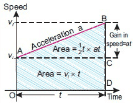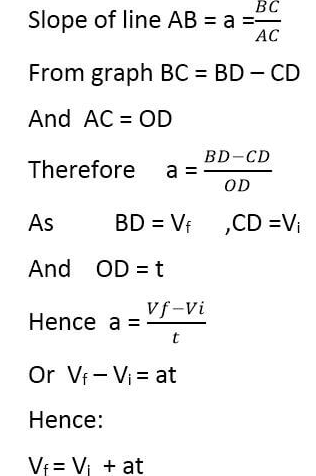Derivation of First Equation of Motion in Physics

The first equation of motion (Vf =Vi + at) deals with final velocity, initial velocity, acceleration, and time. We can use the 1st equation of motion to find final velocity, initial velocity, acceleration, and time.
First equation of motion derivation
Consider a body moving with initial velocity “Vi” with uniform acceleration “a” as shown in the figure. After time “t” its velocity becomes “Vf”.The total distance covered by a body is under the straight line AB which is shaded as shown in the figure. The slope of line AB is acceleration “a”.1st equation of motion can be obtained easily from this speed-time graph.
According to the speed time graph slope of line AB gives the acceleration of a body.

This is the 1st equation of motion in terms of final velocity, initial velocity acceleration and time.
Visit for related topics in our Page: Mechanics
1st equation of motion problems
- A car traveling at 10 m/s accelerates uniformly at 2 m/s. Calculate its velocity after 5 s.
Solution:
Vi = 10 m/s
a = 2 ms¯²
t = 5s
Vf = ?
Formula:
Vf = Vi + at
Vf = 10 m/s + (2 ms¯²)(5s)
Vf = 20 m/s
The velocity of car after 5s will be 20 m/s.
See also:
Second equation of motion
Third equation of motion

It is not good enough for me